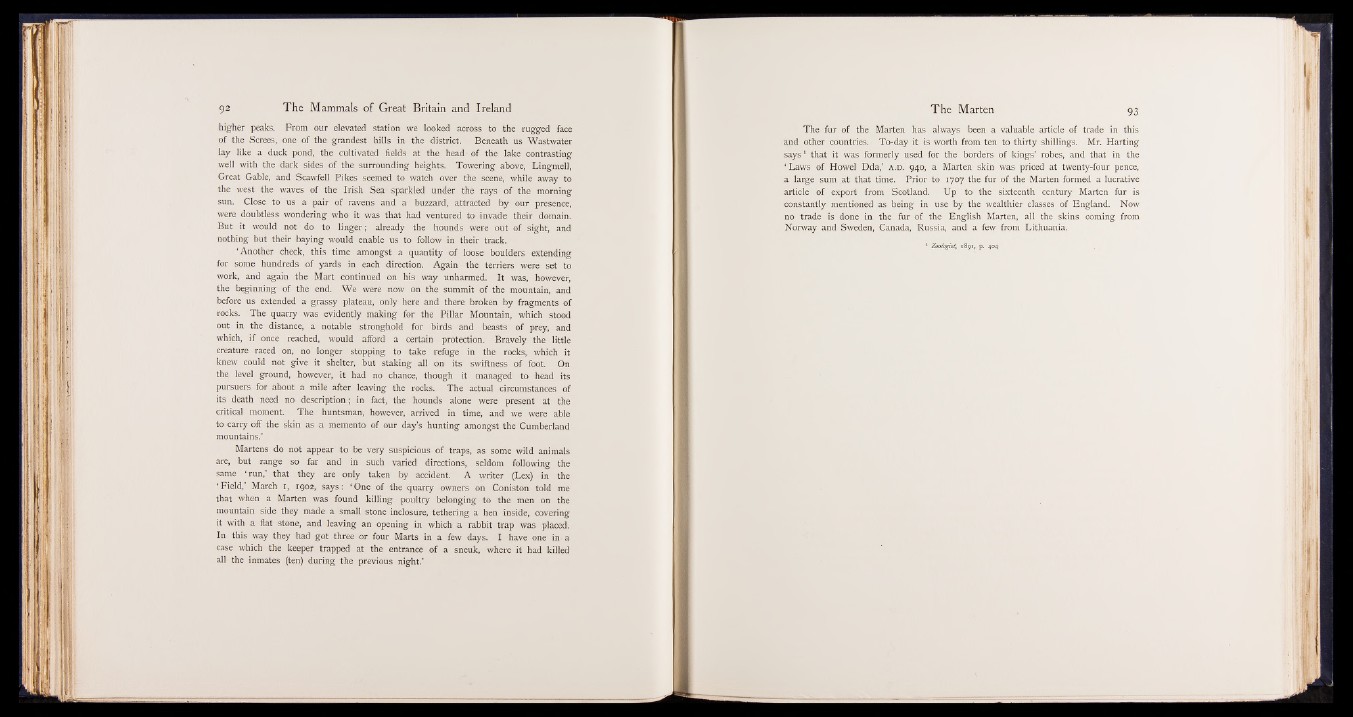
higher peaks. From our elevated station we looked across to the rugged face
of the Screes, one of the grandest hills in the district. Beneath us Wastwater
lay like a duck pond, the cultivated fields at the head- of the lake contrasting
well with the dark sides of the surrounding heights. Towering above, Lingmell,
Great Gable, and Scawfell Pikes seemed to watch over the scene, while away to
the west the waves of the Irish Sea sparkled under the rays of the morning
sun. Close to us a pair of ravens and a buzzard, attracted by our presence,
were doubtless wondering who it was that had ventured to invade their domain.
But it would not do to linger; already the hounds were out of sight, and
nothing but their baying would enable us to follow in their track.
‘ Another check, this time amongst a quantity of loose boulders extending
for some hundreds of yards in each direction. Again the terriers were set to
work, and again the Mart continued on his way unharmed. It was, however,
the beginning of the end. We were now on the summit of the mountain, and
before us extended a grassy plateau, only here and there broken by fragments of
rocks. The quarry was evidently making for the Pillar Mountain, which stood
out in the distance, a notable stronghold for birds and beasts of prey, and
which, if once reached, would afford a certain protection. Bravely the little
creature raced on, no longer stopping to take refuge in the rocks, which it
knew could not give it shelter, but staking all on its swiftness of foot. On
the level ground, however, it had no chance, though it managed to head its
pursuers for about a mile after leaving the rocks. The actual circumstances of
its death need no description; in fact, the hounds alone were present at the
critical moment. The huntsman, however, arrived in time, and we were able
to carry off the skin as a memento of our day’s hunting amongst the Cumberland
mountains.’
Martens do not appear to be very suspicious of traps, as some wild animals
are, but range so far and in such varied directions, seldom following the
same ‘ run,’ that they are only taken by accident. A writer (Lex) in the
‘ Field,’ March i, 1902, says: ‘ One of the quarry owners on Coniston told me
that when a Marten was found killing poultry belonging to the men on the
mountain side they made a small stone inclosure, tethering a hen inside, covering
it with a flat stone, and leaving an opening in which a rabbit trap was placed.
In this way they had got three or four Marts in a few days. I have one in a
case which the keeper trapped at the entrance of a sneuk, where it had killed
all the inmates (ten) during the previous night.’
The fur of the Marten has always been a valuable article of trade in this
and other countries. To-day it is worth from ten to thirty shillings. Mr. Harting
say s 1 that it was formerly used for the borders of kings’ robes, and that in the
‘ Laws of Howel Dda,’ a.d. 940, a Marten skin was priced at twenty-four pence,
a large sum at that time. Prior to 1707 the fur of the Marten formed a lucrative
article of export from Scotland. Up to the sixteenth century Marten fur is
constantly mentioned as being in use by the wealthier classes of England. Now
no trade is done in the fur of the English Marten, all the skins coming from
Norway and Sweden, Canada, Russia, and a few from Lithuania.
Zoologist1891, p. 404